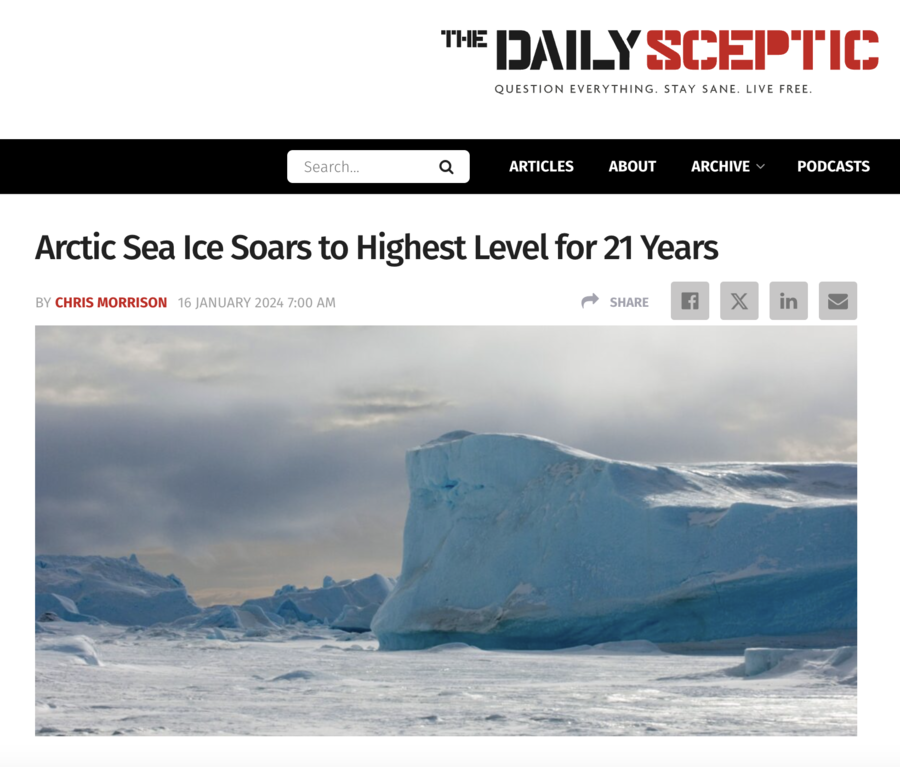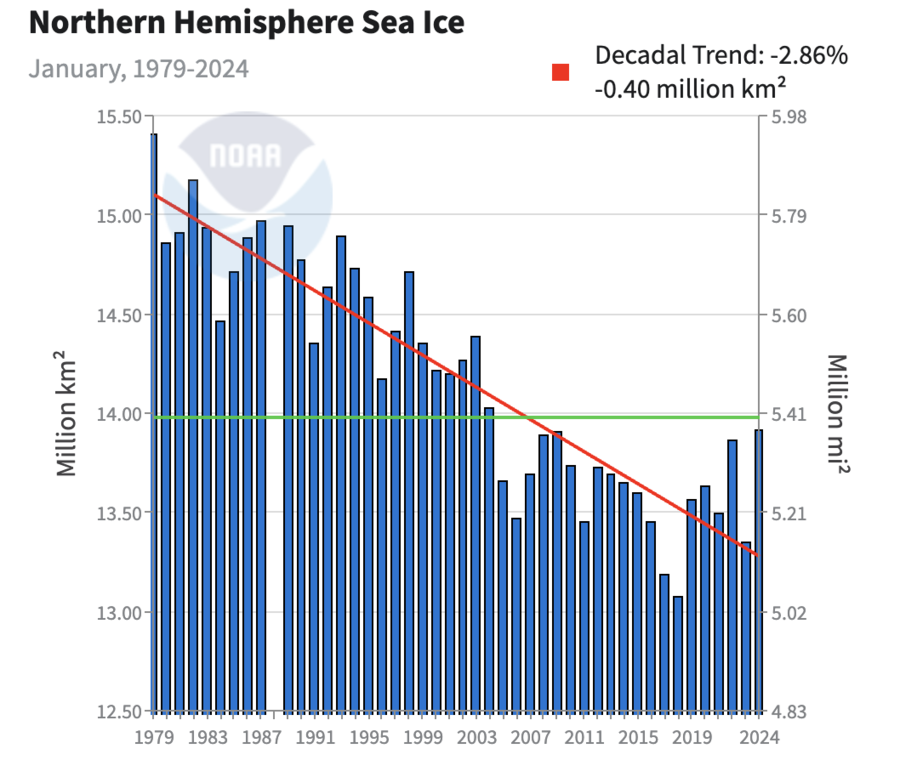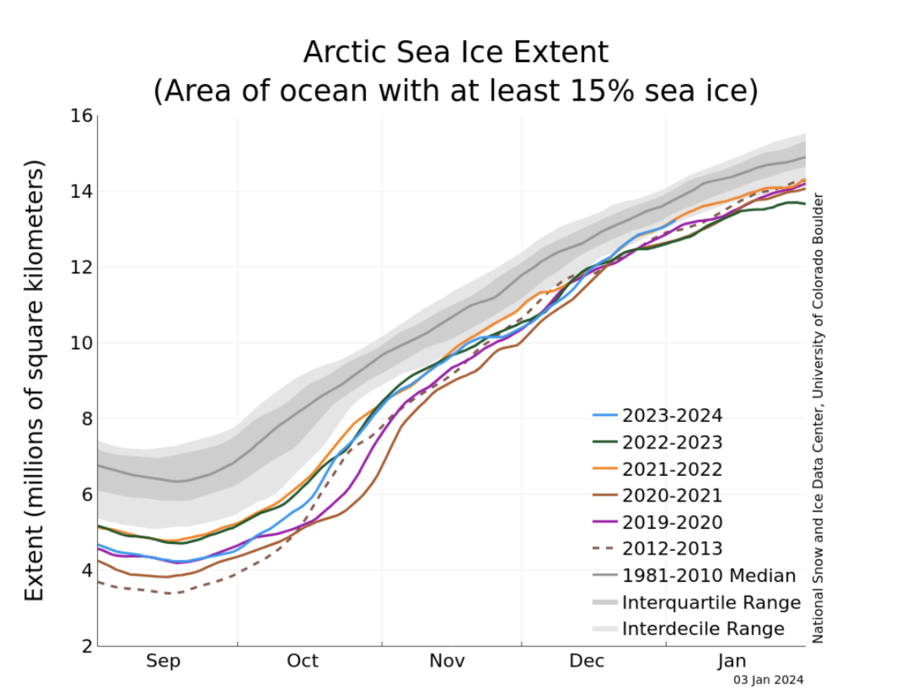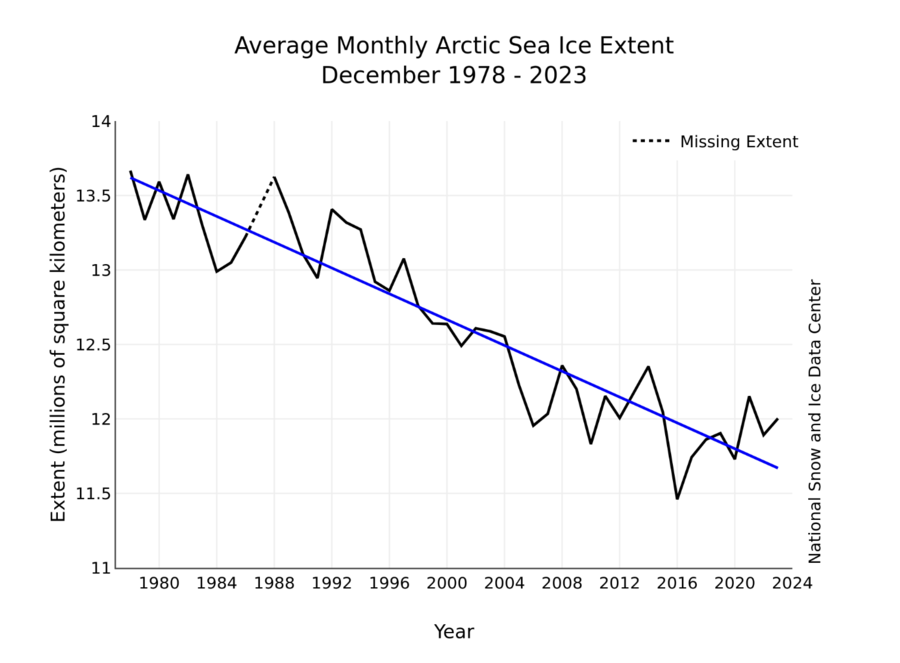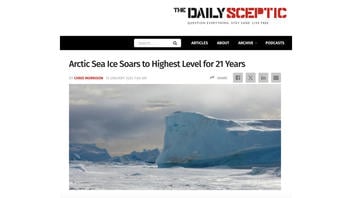
Did data from December 2023 show that Arctic sea ice had soared to its "highest level for 21 years," thus disproving global warming and climate change? No, that's not true: The blog that made this claim cherry-picked genuine data, a senior research scientist told Lead Stories. While it is true that the total area of the Arctic Ocean covered by ice temporarily increased in December 2023, this short-term data point does not prove the extent of Arctic sea ice is increasing, he said.
The claim about increasing Arctic sea ice originated in a post published by the British blog The Daily Sceptic, on January 16, 2024, (archived here). The post was titled, "Arctic Sea Ice Soars to Highest Level for 21 Years." It began:
The dramatic, if largely unpublicised, recovery in Arctic sea ice is continuing into the New Year. Despite the contestable claims of the 'hottest year ever' (and even hotter in 2024), Arctic sea ice on January 8th stood at its highest level in 21 years. Last December, the U.S.-based National Snow and Ice Data Centre (NSIDC) revealed that sea ice recorded its third highest monthly gain in the modern 45-year record. According to the science blog No Tricks Zone, the reading up to January 8th has now far exceeded the average for the years 2011-2020. It also exceeds the average for the years 2001-2010, and points directly upwards with regard to the average for the years 1991-2000.
This is what the post looked like at the time of the writing of this fact check:
(Source: The Daily Sceptic screenshot taken Fri Aug 2 06:34:31 2024 UTC)
Citing data from the University of Colorado Boulder's National Snow and Ice Data Center (NSIDC) (archived here), which provides information about the extent of Arctic and Antarctic sea ice, the post above claimed that "Arctic sea ice on January 8th [2024] stood at its highest level in 21 years."
In response to our query, NSIDC senior research scientist Walt Meier (archived here) told Lead Stories in an email received on August 2, 2024, that, while the data published by The Daily Sceptic is correct, it was cherry-picked. He concluded:
The article notes that we must be careful not to cherry-pick, but ironically that is exactly what they did.
Meier explained:
Winter is a time of greater variability because of weather at the extreme ice edge can cause the ice to expand or contract over few days, so single day comparisons, especially in winter, are not very meaningful. This past winter was less extreme than recent years. The monthly average for January 2024 was the 20th lowest (out of 46) in the satellite record, but it was still lower than average.
Summer is more indicative of warming and climate change because it is a function of the melt and the thickness of the ice more so than the weather. And things have changed substantially since January 2024. Extent loss has been quite rapid during the summer and the current extent is similar to the same date in 2012, which is when the record low minimum extent was record in September. This doesn't mean this year will hit a new record low, but it confirms that the Arctic sea ice is substantially changed - thinner, less compact, more prone to melting - from the earlier part of the record.
Sea ice extent indicates climate change
Sea ice extent is the total area of the Arctic Ocean covered by sea ice at a given time. Scientists measure sea ice extent in two ways: maximum and minimum. This region is an important indicator of changes in global climate because warmer air and water temperatures are reducing the amount of sea ice present, according to the Environmental Protection Agency (archived here).
In the Arctic, sea ice extent generally reaches its annual maximum in March and its annual minimum in September, according to Copernicus (archived here). Between 1979 and 2023, Arctic sea ice extent declined at an average rate of around 3 percent per decade in March, the maximum, and 12 percent per decade in September, the minimum, according to NASA data (archived here).
When collating this data, researchers consider trends over time -- not daily data points, as The Daily Sceptic did. Global trends indicate that Arctic sea ice extent has seen a "marked decline" in the decades since recordkeeping began in 1979, according to the scientific research group Copernicus Institute (archived here).
While December 2023 data did show that the daily sea ice extent jumped temporarily to levels higher than those observed in 2004 on the same date, this only lasted a few days before the level dropped below 2004's.
As of January 2024, data from NSIDC and the National Oceanic and Atmospheric Administration show that the Northern Hemisphere sea ice extent in the "maximum" months has declined nearly 3 percent each decade (archived here):
(Source: NSIDC/NOAA)
Examining December 2023 data in Daily Sceptic
The Daily Sceptic blog included as evidence a link to an NSIDC news release dated July 16, 2024, titled "Peak of the melt season" (archived here). It read, "July is the warmest month in the Arctic and hence also the month of peak sea ice loss."
However, The Daily Sceptic references December 2023 data. Assuming that the link was redirected to the wrong webpage, Lead Stories found NSIDC data (archived here), published on January 4, 2024, that described the extent of the December sea ice.
The data showed that the end of 2023 had above-average sea ice growth, which increased daily "markedly faster" than the 1981 to 2010 average. Overall, December 2023 had the third-highest monthly gain of sea ice in the 45-year record.
The graph below, for example, shows Arctic sea ice extent as of January 3, 2024, compared with daily ice-extent data for the previous year.
(Source: NSIDC)
But Arctic sea ice extent is not trending toward an increase. By comparison, the chart below shows the monthly December ice extent between 1979 and 2023, showing a decline of about 3 percent each decade. (All NSIDC data can be seen here.)
(Source: NSIDC)
The decline in Arctic sea ice extent has slowed since a "hiatus" documented in 2012, the record low summer minimum. Even so, the Arctic sea ice minimum area, meaning the lowest ice recorded in a given year, has steadily declined since records began. NASA published the below visualization (archived here) showing the minimum size of Arctic sea ice each year since 1979, when records began:
At the time of the publication of this fact check, Reuters and Electi Facts also had reviewed The Daily Sceptic's claim about increasing Arctic sea ice.
Lead Stories previously debunked a similar claim that used select data to argue that Arctic ice reached its highest point in 20 years in December 2021. That fact check can be read here.

